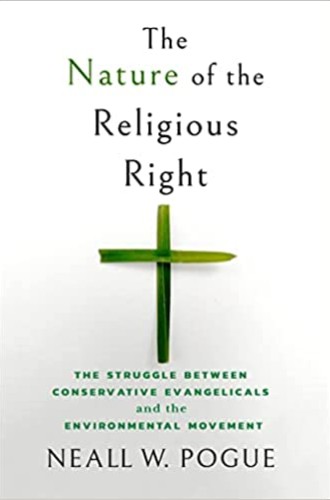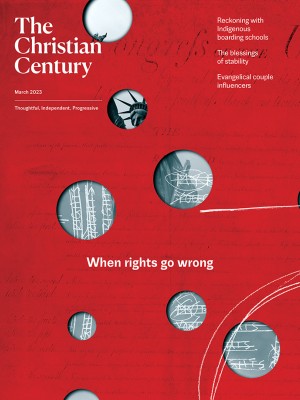Why did conservative evangelicals turn against the environment?
It was mostly politics, argues historian Neall Pogue.
Among the many issues that separate conservative evangelicals from progressive Christians, few may be as perplexing to the latter as conservative opposition to environmentalism. It is almost second nature to liberal Christians that human beings have a responsibility to “care for our common home,” as Pope Francis put it in his 2015 encyclical on climate change, or that Christians are called “to steward God’s creation,” as the National Council of Churches declared in 2006.
Mike Pence, on the other hand, perhaps the most prominent conservative evangelical among recent American politicians, “spent his time in the House [of Representatives] representing the view that polluters should have few restrictions and clean energy should get less support,” according to the Environmental Defense Fund, and these priorities guided his actions as governor of Indiana and as vice president. Jerry Falwell Sr. summarized the reigning view among conservative evangelicals about climate change in a well-publicized 2007 sermon, dismissing it as a fraud.
Read our latest issue or browse back issues.
In The Nature of the Religious Right, historian Neall Pogue delves deeply into the ideology and actions of conservative evangelicals on these issues in order to understand their antipathy to “Christian environmental stewardship.” Tracing such ideas and actions from the 1960s to the 2010s, Pogue finds not only fissures in their stance but a significant shift, beginning in the late 1970s and culminating in 1993–1994.
In the earlier period, Pogue demonstrates, major conservative evangelical institutions—the Southern Baptist Convention, the National Association of Evangelicals, and Christianity Today, among many others—participated in Earth Day events, worked on conservation initiatives, and even issued warnings about global warming. The shift, according to Pogue, was due largely to the conservative evangelical embrace of the broader right-wing Republican agenda. This change of opinion also demonstrates, he suggests, that it is possible that conservative evangelicals—if approached with sensitivity by secular and liberal Christian environmentalists—could be won over once again to a green perspective.
The author provides numerous examples of environmentalist concerns among conservative evangelicals prior to 1990. Eternity magazine marked the first Earth Day with an entire issue bemoaning disrespect for the environment and urging Christians to teach “children how to be conscientious stewards by conserving resources and not polluting.” In his 1988 Republican National Convention address, presidential candidate Pat Robertson called upon Americans to “respect and care for the soil, the forests, and God’s other creatures who share with us the earth, the sky, and the water.”
Most surprising to me, as an educator who closely follows debates over curriculum, was the inclusion in a textbook published by Abeka, popular in conservative Christian schools nationwide, of a vignette praising Sierra Club founder John Muir and “warning about the sin of maximizing profits at the expense of the environment.” Pogue especially credits conservative evangelical intellectual Francis Schaeffer, who wrote extensively in the 1960s about the need for humans to value nature as created by God, for this early environmentalism. The book’s eight pages of graphics include several wonderful examples of conservative evangelical environmentalism.
So why the turnabout? Pogue accords theological interpretations some weight. God commanded humans to subdue the earth and use it for our purposes, some argued, and the special place God reserved for humans means that he will provide abundant resources for our needs into perpetuity. Evangelicalism’s premillennial strain contributed the idea that increased disorder on earth, including pollution and depleted resources, was part of God’s plan. Conservative evangelicals, epitomizing hairsplitting biblical exegesis, accused environmentalists of worshiping nature instead of worshiping the God who created nature.
But Pogue finds politics, and stances on other social issues, to be more decisive than theology in precipitating the shift. In the 1970s, conservative evangelicals came to see environmentalism as connected to feminist and gay rights movements, and so the former became collateral damage in the backlash against the latter. The Christian nationalism of the emerging religious right tied environmentalism to “one-world” globalism, among its biggest bugaboos. The idea of biblical inerrancy, increasingly important as anti-evolution thinking resurfaced, led to growing skepticism about science generally, including by the late 1990s the scientific consensus on human-caused climate change. Falwell “equated the theory of evolution to global warming,” writes Pogue.
Perhaps most importantly, concludes Pogue, as conservative evangelicals found their place almost exclusively in the Republican Party, they made their peace with the pro-growth, less regulation, free enterprise outlook of their political allies and associated think tanks. Thus, to give just two examples, praise for John Muir disappeared from Abeka’s textbooks, and a Southern Baptist Convention official quickly repudiated his own 1991 analysis of global warming.
Pogue carefully delineates the backtracking of many conservative evangelicals on environmentalism, even as he presents the valiant but unsuccessful efforts of the Evangelical Environmental Network’s Ron Sider and climate scientist Katharine Hayhoe, among other evangelicals, to forestall this abandonment of environmental stewardship.
Pogue does not let environmentalists off the hook for the conservative evangelical trajectory. He targets Lynn White Jr.’s influential 1967 article in Science, which blamed the ecological crisis on the Christian conception that humankind should dominate nature. Pogue asserts that this analysis “pushed the willing conservative evangelicals away, worsening a schism that never healed.”
The author occasionally overstates the depth of pre-1990 conservative evangelical environmentalism. And in his conclusion Pogue bends so far backward to present the reasoning behind his subjects’ anti-environmentalism that it is difficult to credit the hope expressed in his final sentence, that Christian environmental stewardship might once again take root among them.
Still, this book deserves study by secular and religious environmentalists, even as one wishes that it find readers among what should be its primary audience: conservative evangelicals.







